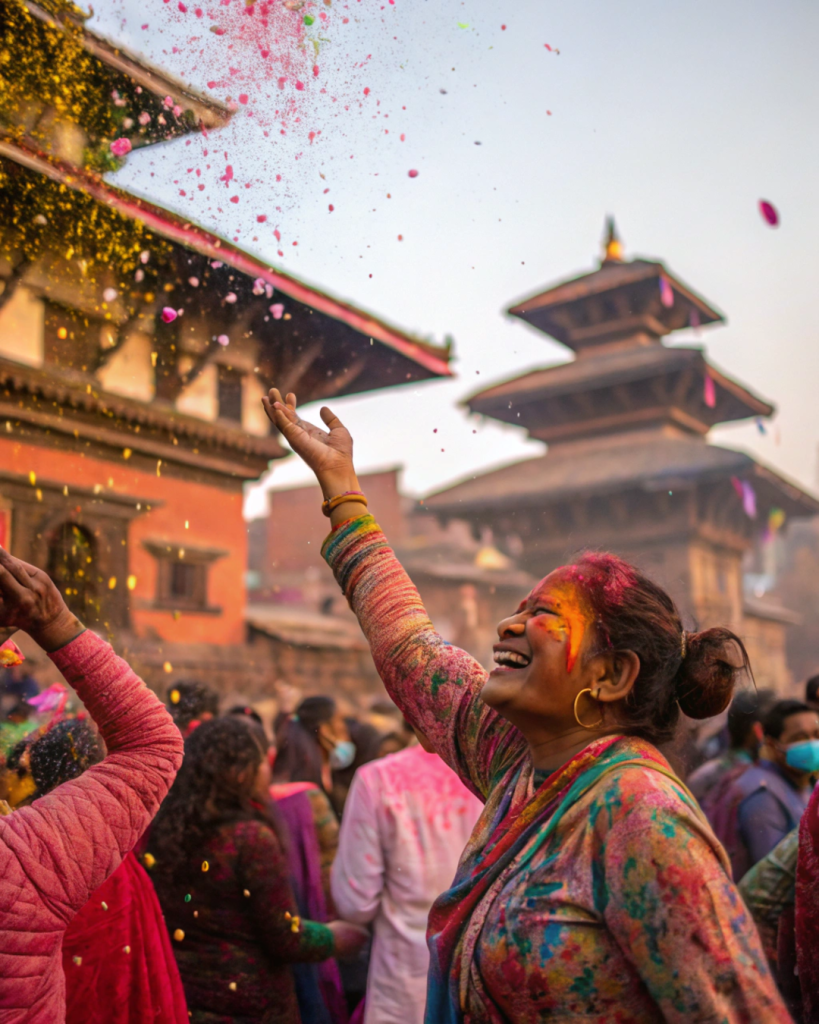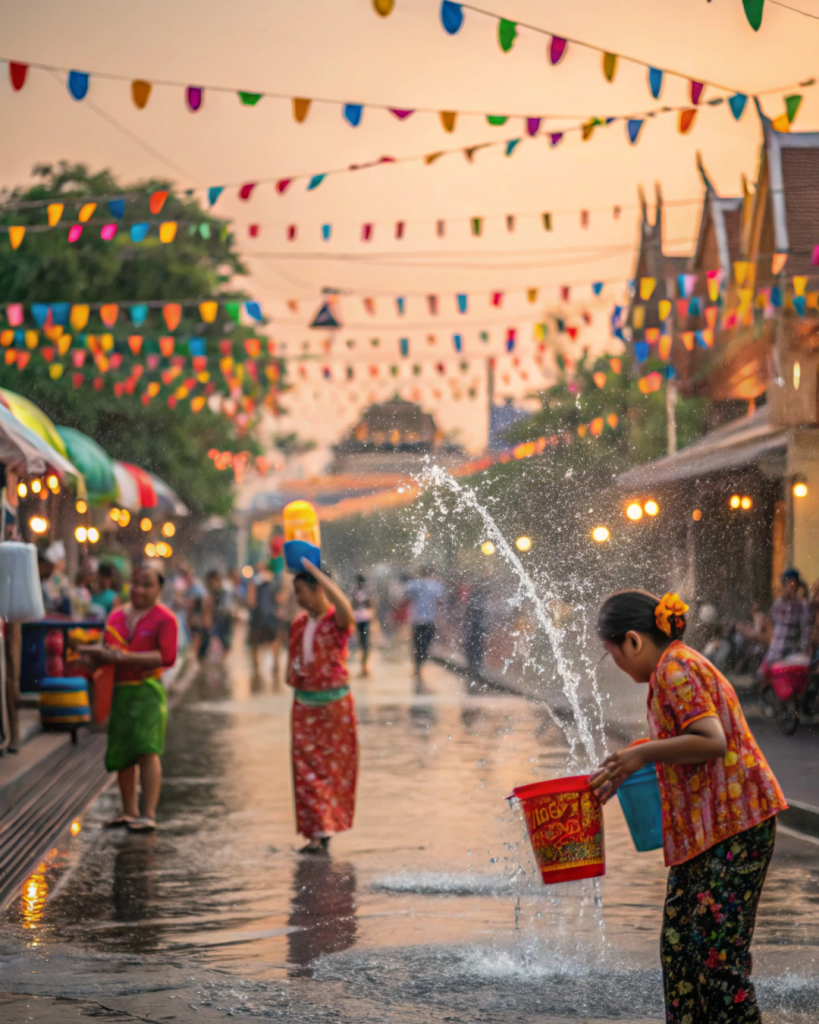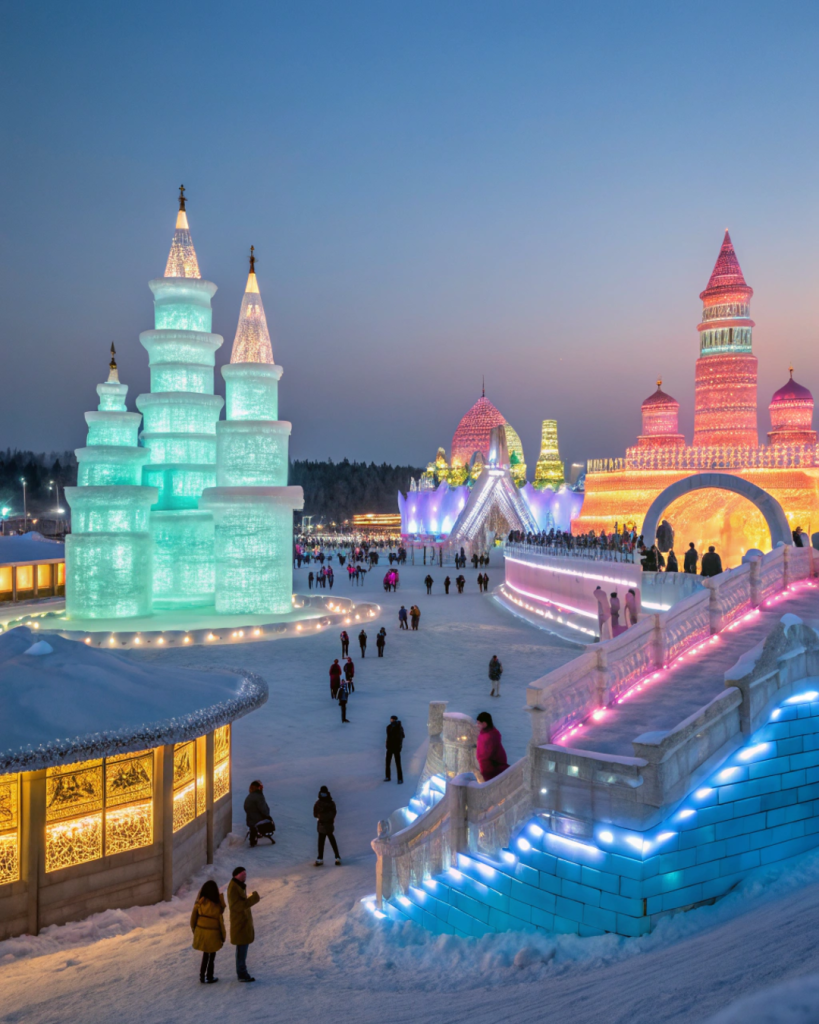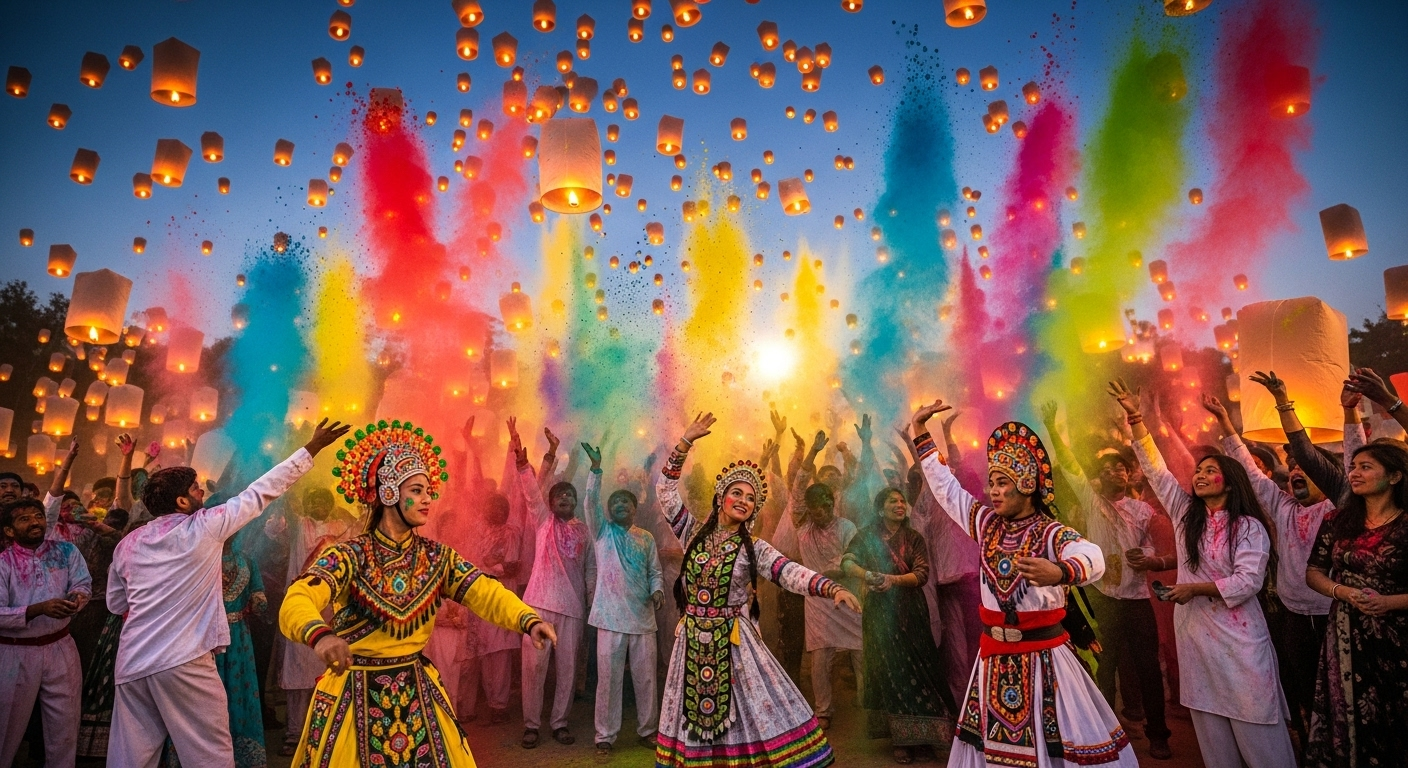I still remember the first time I watched a rain of colored powders descend over a crowded street in Jaipur. I felt like I’d stepped into a dream — laughter all around, people dancing, strangers ditching their hesitation and smearing each other with bright pigment. That was my initiation into Asia’s festival life. Over the years, I’ve chased lanterns across rivers in Thailand, waded through mud pools in Korea, floated candle-lit baskets in Laos, and watched majestic masks in Bhutan. Through it all, I learned that the most colorful festivals in Asia are more than spectacles — they are portals into the soul of local tradition, joy, and community.
If you’re the traveler who dreams of vibrant moments, whether solo, with family, or venturing into the unknown, here’s my curated list of 8 Most Colorful Festivals in Asia — and how you can experience them fully, smartly, and joyfully.
🎉 What Makes a Festival “Colorful”?
By “colorful,” I mean more than just visual spectacle (though that’s a big part). I’m referring to festivals that engage all your senses: vivid tapestries of ritual, moving processions, crowd energy, communal participation, edible flavors, soundscapes, and moments when — whether through paint, lights, water, or costumes — you feel immersed in the local story.
As you read this, imagine yourself not as an observer, but as an active participant. That’s how I’ve always traveled — looking for moments where I’m not just seeing, but doing, being, and learning.
1. Holi — India & Nepal

Timing: Late February / March (first full moon of Phalguna)
Why It’s a Must: The original “festival of colors,” Holi breaks down walls — caste, background, traveler vs. local. You end covered head to toe in brilliant powders, laughing and bonding. Live Is to Travel+3Cathay Pacific+3Secret Retreats+3
My Experience & Tips
In Jaipur, I joined a local group at dawn. The moment someone flung magenta pink powder at me, our laughter melted any shyness. I made new friends in five minutes.
- Wear clothes you don’t care about (white T-shirt tops are classic — the color shows up best).
- Use biodegradable powder; many local organizers now use eco-friendly types.
- Protect your eyes and hair (sunglasses, a bandana) — though part of the fun is letting it cover you, too.
- Go in with a playful spirit — locals appreciate when travelers join in without hesitation.
Practical Advice
- Many guides or homestays will include Holi in their packages — you can join neighborhoods rather than mainstream “tourist Holi.”
- Carry a small dry shampoo or baby powder to clean hands/face afterward.
- Budget: modest — the biggest cost is transport and sometimes a gathering fee if the event is organized.
2. Songkran — Thailand (and water-festivals elsewhere)

Timing: April 13–15 (Thai New Year)
Why It’s a Must: Songkran turns the whole country into a giant water fight. Streets become rivers, laughter echoes everywhere, and the symbolism — of cleansing, renewal, playful mischief — is powerful. Live Is to Travel+3Globe Drifters+3Secret Retreats+3
My Experience & Tips
I first experienced Songkran in Chiang Mai. The first splash felt like crossing a threshold: every stranger becomes an ally. I was soaked within five minutes — in the best way.
- Use waterproof pouches for your phone and passport (don’t underestimate the spray).
- Locals often gently pour scented water over Buddha statues, elders, and monks — observe local etiquette (e.g. don’t splash monks).
- Choose your zone: temple precincts are calmer; main streets are chaotic fun.
- After dark, the splashing dies down, and people light lanterns — a magical contrast of water and light.
Practical Advice
- Book accommodation well in advance: hotels fill up fast.
- Do your festival wandering on foot or bike — roads may close.
- Budget for extra laundry or drying time.
- In other countries like Myanmar (Thingyan) or Laos, similar water-based New Year festivals exist — you might find smaller, less touristy versions.
3. Loy Krathong & Yi Peng — Thailand
Timing: November (full moon of the 12th lunar month)
Why It’s a Must: In this festival of lights, floating baskets (krathongs) drift on rivers, and thousands of lanterns soar into the night sky. It’s deeply symbolic — letting go, hope, wishes — and visually unforgettable. Secret Retreats+3Globe Drifters+3trafalgar.com+3
My Experience & Tips
In Chiang Mai during Yi Peng, I watched hundreds of lanterns ascend simultaneously. I remember stepping back, my jaw slack, feeling my heart catch.
- Pre-order a lantern release if possible (local organizers often sell them together).
- Launch your krathong near dusk; if you wait too late, you might miss the crowd momentum.
- Make sure your floating basket is biodegradable — it’s part of local environmental efforts.
- For social media magic: frame your shot with lanterns overhead and river reflections below.
Practical Advice
- Check moon calendars — the dates shift each year.
- Combine Loy Krathong with temple visits, local dance shows, floating markets.
- Stick close to locals to learn the correct placing of baskets (some rituals accompany it).
- Budget: moderate — payoff is high for the ambiance.
4. Boryeong Mud Festival — South Korea
Timing: Late July to early August (approx. 2 weeks) Wikipédia+5Odynovo Tours+5VISITKOREA – Imagine Your Korea+5
Why It’s a Must: It’s weird, messy, joyful — and that’s the point. Mud slides, mud pools, mud massages, concerts — this is not a passive festival. You will get dirty. mudfestival.or.kr+2VISITKOREA – Imagine Your Korea+2
My Experience & Tips
The first time I arrived, I hesitated at the mud pits. Then someone pushed me in. I emerged laughing, coated in gray clay.
- Bring an extra towel, flip-flops, and a plastic bag for wet clothes.
- Some mud is pigmented or mixed with mineral colors — it’s part of the spectacle.
- Rinse stations are set up, but expect to use seawater or shared showers.
- Evening concerts and fireworks add a party vibe.
Practical Advice
- Book lodging in Daecheon Bay area months ahead — festival week gets crowded.
- Buy tickets online in advance; there may be “mud zones” requiring separate tickets.
- Combine with a short Korea coastal road trip to fully enjoy.
- Budget: higher than a local festival, but still manageable if you avoid luxury hotels.
5. Harbin Ice & Snow Festival — China

Timing: January to March (winter)
Why It’s a Must: Okay, “colorful” is in the lights, not pigments: giant ice sculptures lit with neon lights, tunnels of colored ice, glowing castles. It’s an otherworldly frozen wonderland. travelzone.bestwestern.com+1
My Experience & Tips
I visited Harbin during Lunar New Year. In the evening, the sculptures glowed like fantasy kingdoms. I walked hours, camera in hand, entranced by light, reflection, cold.
- Dress for serious cold (thermal layers, insulated boots).
- Go right at dusk — that’s when lights pop.
- Take guided tours (especially for hidden sculpture zones).
- Respect the display boundaries — ice is fragile.
Practical Advice
- Train or fly into Harbin well in advance; attractions are scattered.
- Pair the Ice Festival with nearby snow towns or local cultural performances.
- Budget: medium to high (cold-region travel costs add up).
- Book hotel with good heating.
6. Thimphu Tshechu — Bhutan
Timing: September – October (dates vary by region) Your Travel Nation+1
Why It’s a Must: Bhutan’s masked dance ritual festival is steeped in spiritual color. Enormous “thongdrel” tapestries, bright monk’s robes, masked dance sequences that tell sacred stories. It feels sacred and celebratory.
My Experience & Tips
I sat among locals in the dzong courtyard as giant tapestries rolled out at dawn; the air felt holy. I realized I was witnessing centuries-old spiritual expression.
- Get your Bhutan permit/tour in order (mandatory for foreign visitors).
- Dress conservatively — respectful clothing, shoes you can easily remove.
- Arrive early — the best viewing spots fill quickly.
- Listen and observe — local elders know the stories behind each mask’s movement.
Practical Advice
- Leverage local Bhutan tour operators (they handle logistics, dress code, guides).
- Combine your festival with hikes, valley treks, monasteries — Bhutan is layered.
- Budget: higher than average — Bhutan’s “high-value, low-impact” model means set daily tariffs.
- Plan buffer days for weather or event schedule shifts.
7. Lantern Festival / Yuan Xiao Jie — China & Taiwan
Timing: Fifteenth day of the first lunar month (February / March)
Why It’s a Must: The skies and waterways glow with lanterns. Intricately shaped lanterns (animals, mythic forms) float or fly; riddle-solving, performances, fireworks add to the cultural tapestry. travelzone.bestwestern.com+1
My Experience & Tips
In Taiwan, I watched my lantern drift skyward — the hush, the collective breath, the brilliance — unforgettable.
- Buy a lantern with flame protection; many festivals have safety rules.
- Craft your wish carefully before releasing.
- Around the lantern displays, engage in local riddle-games and traditional foods (tangyuan, sticky rice balls).
- Stay until the “grand release” moment — sometimes thousands of lanterns go up at once.
Practical Advice
- Confirm the local Lunar calendar date (shifts yearly).
- For big displays, arrive early to nab a release spot.
- Pair with temple fairs, cultural performances, street food tours that night.
- Budget: modest-to-moderate — often low ticket price, travel cost is main factor.
8. Pushkar Camel Fair — Rajasthan, India
Timing: November (Kartik full moon)
Why It’s a Must: Though primarily a livestock fair, the festival blooms with color: camels parading in decorated finery, folk dances in bright garments, local markets awash in textile hues, turban competitions, and a carnival atmosphere. Globe Drifters+2trafalgar.com+2
My Experience & Tips
At dawn, I wandered through tents of camel traders. The colors of turbans, the intricate embroidery on camels — it felt like walking through living folk art. Later, I watched camel races, musical performances, and sat at a rooftop cafe watching the sunset over the desert.
- Stay in Pushkar town to be part of the action (don’t commute from Ajmer).
- Wear comfortable shoes — dusty ground, walking between camps.
- Join local folk dance circles — they’ll often invite you.
- Negotiate gently in marketplaces — you’re part of the scene, not just a tourist.
Practical Advice
- Book accommodations early — small hotels and guesthouses fill fast.
- Combine with a Rajasthan circuit: Jaipur, Jodhpur, Udaipur.
- Budget: mid-range, though the fair’s side markets let you splurge strategically.
- Carry water, sunscreen, and dust protection (scarf, goggles).
✈ Planning, Budgeting & Travel Hacks for Festival Chasing in Asia
Timing & Calendars
- Festivals often follow lunar calendars (Holi, Lunar New Year, Lantern Festival), so dates shift yearly.
- Use local tourism boards or festival websites to confirm dates before booking.
- Allow buffer days for weather, delays, or festival extensions.
Booking Smart
- Secure your flights and lodging early — especially in festival towns.
- Choose centrally located lodging so you can walk or avoid traffic snarls.
- Ask your host or guide for local festival schedules — often spontaneous events pop up.
Packing & Gear
- Always carry a light daypack with waterproof pouches for electronics.
- Bring basics: sunscreen, sunglasses, rain jacket, extra socks, microfiber towel.
- For messy festivals (Holi, mud festivals), pack clothes you won’t mourn.
- Use universal power adapters, portable chargers — especially in remote areas.
Budget Tips
- Use local transport (buses, trains) wherever safe and feasible — you’ll stretch your money further.
- Eat local — festival food stalls often serve the best, cheapest, most authentic meals.
- Carry cash for small purchases — some vendors don’t accept cards.
- Group up when you can — shared taxis, bundled day tours, shared equipment.
Safety & Etiquette
- Respect local customs and dress codes (especially in religious ceremonies).
- Watch pickpockets in crowded events; use money belts.
- Check travel advisories for the region around festival time.
- Be mindful of noise and crowd fatigue — pace yourself.
- Engage respectfully: ask before photographing people in ritual moments.
Immersion Over Observation
I’ve always believed that the deepest moments come when you step beyond spectator mode. At the lantern festival in Thailand, I joined in crafting a floating lantern. In Bhutan, I sat quietly with locals during a masked dance interlude. In Korea’s mud festival, someone offered me an herbal scrub mid-mud. Those are the moments I carry — when I stop being “tourist” and become “guest.”
🎯 Why These 8 Festivals? And Others You Should Explore
There are dozens more — flower festivals, harvest celebrations, temple fairs — but I chose these eight because they combine accessibility, visual impact, deep cultural resonance, and emotional immersion. They span a variety of climates and traditions, giving you options across seasons and interests.
If you love this topic, you might also enjoy my post “Exploring Southwest Asia: A Journey Through Culture, History, and Natural Beauty” — and you can check it out here for more regional inspiration.
Final Thoughts — Go Let Asia Paint You
As I’ve chased festivals across Asia, a lesson has stood out: the magic isn’t just in the hues, the lanterns, or the powdered skies. It’s in the moments where strangers greet you with a smile, where you feel your heartbeat sync with drums, where the festival’s energy lifts your guard and opens your heart.
So here’s my challenge to you: pick one of these festivals — the one that makes your pulse race a little faster — and go. Don’t wait for the “perfect time” — these festivals are ephemeral. Book that flight, trust your curiosity, and let Asia’s colors splash into your story.
Pack your bags, clear your spirit, and discover the magic of Asia — one festival at a time.
“Travel is the only thing you buy that makes you richer.”
Go find your festival.

